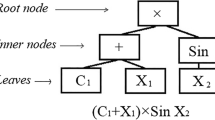Abstract
In order to establish successful flood control strategies to prevent or alleviate severe flood damages, real-time optimization-based control can be a supplementary strategy, besides setting operating rules (regulations) for the hydraulic structures. This research combines evolutionary optimization, by means of a Genetic Algorithm (GA), with the Model Predictive Control (MPC) technique to develop and test a real-time flood control method for the 12 gated weirs in the Belgian case study of the river Demer. The evolution of this method is also the main contribution of this study. The combination of GA with MPC allows coping with the highly nonlinear system behaviour and local minimum problems. The system searches for better control actions by minimizing a cost function while at the same time avoiding violation of the defined constraints. The optimization results testify that the system is able to assist the current regulation strategies that are based on fixed regulation rules (three-position controller).




Similar content being viewed by others
References
Barjas Blanco T, Willems P, Chiang P-K, Haverbeke N, Berlamont J, De Moor B (2010) Flood regulation using nonlinear model predictive control. Control Eng Pract 18(10):1147–1157. doi:10.1016/j.conengprac.2010.06.005
Barsa R, Haberb R, Schmitzb U, Preitla Z (2005) Some practical aspects of model predictive control. In: International Conference on Optimization and Control. pp 1–11
Breckpot M, Agudelo OM, Meert P, Willems P, De Moor B (2013) Flood control of the Demer by using model predictive control. Control Eng Pract 21(12):1776–1787. doi:10.1016/j.conengprac.2013.08.008
Chau K-W (2007) An ontology-based knowledge management system for flow and water quality modeling. Adv Eng Softw 38(3):172–181
Chen W, Chau K (2006) Intelligent manipulation and calibration of parameters for hydrological models. Int J Environ Pollut 28(3):432–447
Chiang P-K, Willems P (2013) Model conceptualization procedure for river (flood) hydraulic computations: case study of the Demer River, Belgium. Water Resour Manag 27(12):4277–4289. doi:10.1007/s11269-013-0407-z
Clarke D (1994) Advances in model-based predictive control. Oxford University Press, Oxford
Delgoda D, Saleem S, Halgamuge M, Malano H (2013) Multiple model predictive flood control in regulated river systems with uncertain inflows. Water Resour Manag 27(3):765–790. doi:10.1007/s11269-012-0214-y
Goldberg DE (1989) Genetic algorithms in search, optimization, and machine learning. Addison-Wesley Professional, Reading
HIC (2003) The Digital Demer: a new and powerful instrument for water level management (in Dutch), hydrologic information service of the authorities of flanders, Borgerhout, Belgium
Holland J (1975) Adaptation in natural and artificial systems. the University of Michigan Press, Ann Arbor
Hu X-B, Chen W-H (2005) Genetic algorithm based on receding horizon control for arrival sequencing and scheduling. Eng Appl Artif Intell 18(5):633–642. doi:10.1016/j.engappai.2004.11.012
Igreja J, Lemos J (2009) Nonlinear model predictive control of a water distribution canal pool. In: Magni L, Raimondo D, Allgöwer F (eds) Nonlinear model predictive control, vol 384, Lecture Notes in Control and Information Sciences. Springer, Germany, pp 521–529. doi:10.1007/978-3-642-01094-1_42
Kumar D, Reddy M (2006) Ant colony optimization for multi-purpose reservoir operation. Water Resour Manag 20(6):879–898
Maestre JM, Raso L, Van Overloop PJ, De Schutter B Distributed tree-based model predictive control on an open water system. In: Proceedings of the 2012 American Control Conference (ACC 2012), Montréal, Canada, 27–29 June 2012. pp 1985–1990
Muttil N, Chau K-W (2006) Neural network and genetic programming for modelling coastal algal blooms. Int J Environ Pollut 28(3):223–238
Nunez A, Saez D, Oblak S, Skrjanc I (2009) Fuzzy-model-based hybrid predictive control. ISA Trans 48(1):24
Onnen C, Babuska R, Kaymak U, Sousa JM, Verbruggen HB, Isermann R (1997) Genetic algorithms for optimization in predictive control. Control Eng Pract 5(10):1363–1372. doi:10.1016/s0967-0661(97)00133-0
Schwanenberg D, Ochterbeck T, Gooijer J, Xu M, Van Heeringen K (2012) Model predictive control of pumps and gates for draining dutch polder systems. In: Proceedings of the 10th International Conference on Hydroinformatics (HIC 2012), Hamburg, Germany, 14–18 July 2012
Taormina R, K-w C, Sethi R (2012) Artificial neural network simulation of hourly groundwater levels in a coastal aquifer system of the Venice lagoon. Eng Appl Artif Intell 25(8):1670–1676
Van Overloop P-J, Weijs S, Dijkstra S (2008) Multiple model predictive control on a drainage canal system. Control Eng Pract 16(5):531–540
Van Steenbergen N, Willems P (2012) Assessment of model improvement actions in river hydrodynamic modelling. In: Proceedings of the 6th International Conference on Fluvial Hydraulics (River Flow 2012), San Jose, Costa Rica, 5–7 September 2012. pp 1219–1225
Wahlin BT, Clemmens AJ (2006) Automatic downstream water-level feedback control of branching canal networks: theory. J Irrig Drain Eng 132(3):198–207
Yang K, Zheng J, Yang M, Zhou R, Liu G (2013) Adaptive genetic algorithm for daily optimal operation of cascade reservoirs and its improvement strategy. Water Resour Manag 27(12):4209–4235. doi:10.1007/s11269-013-0403-3
Yazdi J, Salehi Neyshabouri SAA (2012) A simulation-based optimization model for flood management on a watershed scale. Water Resour Manag 26(15):4569–4586
Acknowledgments
The full hydrodynamic InfoWorks-RS model of the Demer basin and the validated hydrometric data were provided by the Division Operational Water Management of the Flemish Environment Agency (VMM). We also acknowledge Innovyze for the InfoWorks-RS software and license.
Author information
Authors and Affiliations
Corresponding author
Rights and permissions
About this article
Cite this article
Chiang, PK., Willems, P. Combine Evolutionary Optimization with Model Predictive Control in Real-time Flood Control of a River System. Water Resour Manage 29, 2527–2542 (2015). https://doi.org/10.1007/s11269-015-0955-5
Received:
Accepted:
Published:
Issue Date:
DOI: https://doi.org/10.1007/s11269-015-0955-5




